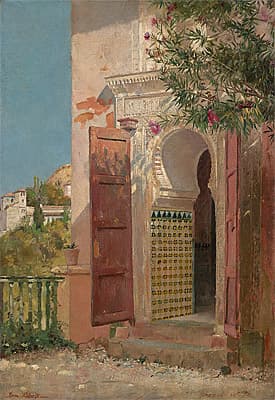Tom
ROBERTS
England
1856
–
Kallista
1931 AD
Australia from 1869; England, Europe 1881- 85, 1903-23
48.3 (h) x 33.3 (w) cm
signed l.l., 'Tom Roberts' inscribed l.r., 'Granada Oct./83'
Reference: 20 National Gallery of Victoria, Melbourne The Joseph Brown Collection, presented through the NGV Foundation by Dr Joseph Brown AO OBE, Honorary Life Benefactor, 2004
How a passion for travel defined a nation
While travelling through Spain when he was 27, Tom met two Spanish artists Ramón Casas and Laureà Barreau who urged him to get out there and paint a ‘direct sketch’ in front of the subject. This kicked off a lifelong passion for Tom to paint in the open air. It also ignited a remarkable lust for travel, unprecedented for many artists of the time.
Tom knew the Australian landscape so well because he spent so much time in it. Just before Christmas in 1886, when Tom was 30 he went to Brocklesby Station at Corowa, New South Wales, for the wedding of one of his cousins.
He would return to Brocklesby again and again to paint Shearing the rams, finishing the picture in 1890. The painting would become the defining image of an emerging nation, ‘lit warm with the reflection of Australian sunlight,’ as Tom described it.
Tom went back to the area to paint a droving scene, settling at Collendina Station 18 kilometres west of Corowa for preliminary sketches of A break away! and finishing it at the woolshed at Brocklesby as well as in his studio in Melbourne.
Tom rode enormous distances in search of things to paint. In one trip he rode 350 miles (570 kilometres) on the back of a horse from Sydney to Inverell, spending Christmas and New Year there to work on The Golden Fleece and In a corner on the Macintyre. He also found the location for Bailed Up on the old Armidale to Inverell Road.
Tom’s travels took him further than any other major artist of his generation. In 1892 he worked his way up the East coast of Australia, north to Queensland and the Torres Strait Islands, crewing to Cooktown on the pearling lugger Jessie.
On this trip, he made studies of Aboriginal people showing a sensitivity uncommon at the time, Aboriginal head, Charlie Turner was later bought by the Art Gallery of New South Wales. One of the first of his works to enter a public collection.
Tom also captured the Australian spirit in his writings of his trips, which remain an iconic perception of Australian’s today, “the children are sturdy and well-built…and the men look finely and are vigorous and hearty, and never wanting in the kindness to a stranger which is so characteristic of the Australian.”
